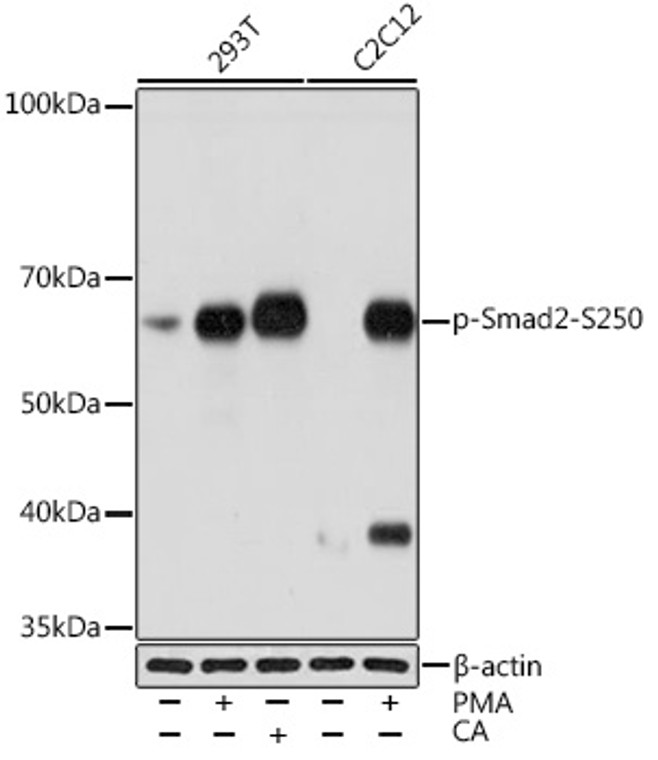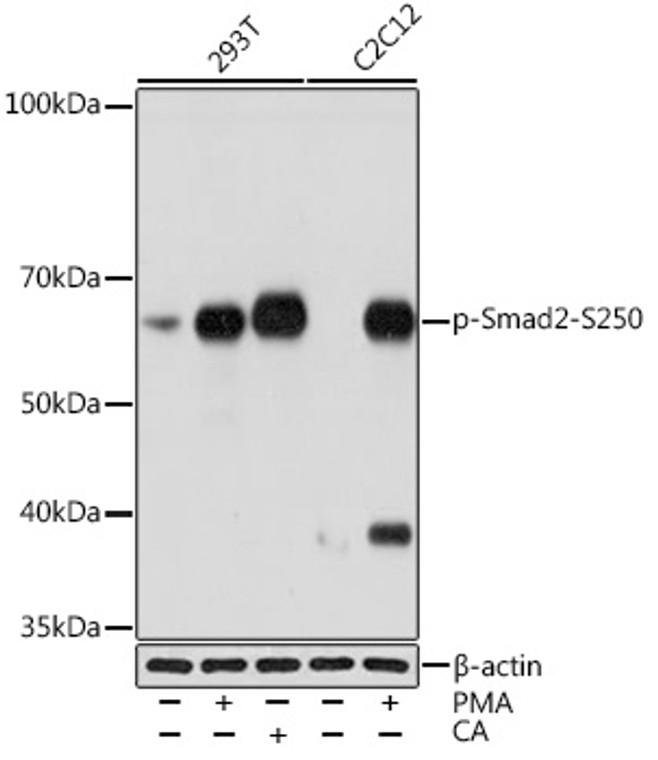| Host: |
Rabbit |
| Applications: |
WB |
| Reactivity: |
Human/Mouse |
| Note: |
STRICTLY FOR FURTHER SCIENTIFIC RESEARCH USE ONLY (RUO). MUST NOT TO BE USED IN DIAGNOSTIC OR THERAPEUTIC APPLICATIONS. |
| Short Description: |
Rabbit monoclonal antibody anti-Phospho-Smad2-S250 is suitable for use in Western Blot research applications. |
| Clonality: |
Monoclonal |
| Clone ID: |
S5MR |
| Conjugation: |
Unconjugated |
| Isotype: |
IgG |
| Formulation: |
PBS with 0.02% Sodium Azide, 0.05% BSA, 50% Glycerol, pH7.3. |
| Purification: |
Affinity purification |
| Dilution Range: |
WB 1:500-1:2000 |
| Storage Instruction: |
Store at-20°C for up to 1 year from the date of receipt, and avoid repeat freeze-thaw cycles. |
| Gene Symbol: |
SMAD2 |
| Gene ID: |
4087 |
| Uniprot ID: |
SMAD2_HUMAN |
| Immunogen: |
A synthetic phosphorylated peptide around S250 of human Smad2 (Q15796). |
| Immunogen Sequence: |
DQQLNQSMDTGSPAELSPTT LSPVNHSL |
| Tissue Specificity | Expressed at high levels in skeletal muscle, endothelial cells, heart and placenta. |
| Post Translational Modifications | Phosphorylated on one or several of Thr-220, Ser-245, Ser-250, and Ser-255. In response to TGF-beta, phosphorylated on Ser-465/467 by TGF-beta and activin type 1 receptor kinases. TGF-beta-induced Ser-465/467 phosphorylation declines progressively in a KMT5A-dependent manner. Able to interact with SMURF2 when phosphorylated on Ser-465/467, recruiting other proteins, such as SNON, for degradation. In response to decorin, the naturally occurring inhibitor of TGF-beta signaling, phosphorylated on Ser-240 by CaMK2. Phosphorylated by MAPK3 upon EGF stimulation.which increases transcriptional activity and stability, and is blocked by calmodulin. Phosphorylated by PDPK1. In response to TGF-beta, ubiquitinated by NEDD4L.which promotes its degradation. Monoubiquitinated, leading to prevent DNA-binding. Deubiquitination by USP15 alleviates inhibition and promotes activation of TGF-beta target genes. Ubiquitinated by RNF111, leading to its degradation: only SMAD2 proteins that are 'in use' are targeted by RNF111, RNF111 playing a key role in activating SMAD2 and regulating its turnover. Acetylated on Lys-19 by coactivators in response to TGF-beta signaling, which increases transcriptional activity. Isoform short: Acetylation increases DNA binding activity in vitro and enhances its association with target promoters in vivo. Acetylation in the nucleus by EP300 is enhanced by TGF-beta. |
| Function | Receptor-regulated SMAD (R-SMAD) that is an intracellular signal transducer and transcriptional modulator activated by TGF-beta (transforming growth factor) and activin type 1 receptor kinases. Binds the TRE element in the promoter region of many genes that are regulated by TGF-beta and, on formation of the SMAD2/SMAD4 complex, activates transcription. Promotes TGFB1-mediated transcription of odontoblastic differentiation genes in dental papilla cells. Positively regulates PDPK1 kinase activity by stimulating its dissociation from the 14-3-3 protein YWHAQ which acts as a negative regulator. May act as a tumor suppressor in colorectal carcinoma. |
| Protein Name | Mothers Against Decapentaplegic Homolog 2Mad Homolog 2Mothers Against Dpp Homolog 2Jv18-1Mad-Related Protein 2Hmad-2Smad Family Member 2Smad 2Smad2Hsmad2 |
| Database Links | Reactome: R-HSA-1181150Reactome: R-HSA-1502540Reactome: R-HSA-2173788Reactome: R-HSA-2173789Reactome: R-HSA-2173795Reactome: R-HSA-2173796Reactome: R-HSA-3304356Reactome: R-HSA-3311021Reactome: R-HSA-3315487Reactome: R-HSA-3656532Reactome: R-HSA-452723Reactome: R-HSA-5689880Reactome: R-HSA-9615017Reactome: R-HSA-9617828Reactome: R-HSA-9754189Reactome: R-HSA-9796292Reactome: R-HSA-9823730 |
| Cellular Localisation | CytoplasmNucleusCytoplasmic And Nuclear In The Absence Of Tgf-BetaOn Tgf-Beta StimulationMigrates To The Nucleus When Complexed With Smad4 Or With Ipo7On Dephosphorylation By Phosphatase Ppm1aReleased From The Smad2/Smad4 ComplexAnd Exported Out Of The Nucleus By Interaction With Ranbp1Localized Mainly To The Nucleus In The Early Stages Of Embryo Development With Expression Becoming Evident In The Cytoplasm At The Blastocyst And Epiblast Stages |
| Alternative Antibody Names | Anti-Mothers Against Decapentaplegic Homolog 2 antibodyAnti-Mad Homolog 2 antibodyAnti-Mothers Against Dpp Homolog 2 antibodyAnti-Jv18-1 antibodyAnti-Mad-Related Protein 2 antibodyAnti-Hmad-2 antibodyAnti-Smad Family Member 2 antibodyAnti-Smad 2 antibodyAnti-Smad2 antibodyAnti-Hsmad2 antibodyAnti-SMAD2 antibodyAnti-MADH2 antibodyAnti-MADR2 antibody |
Information sourced from Uniprot.org
12 months for antibodies. 6 months for ELISA Kits. Please see website T&Cs for further guidance








